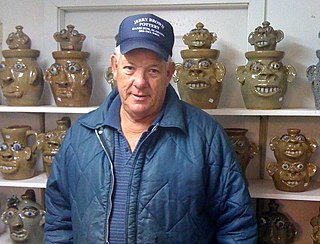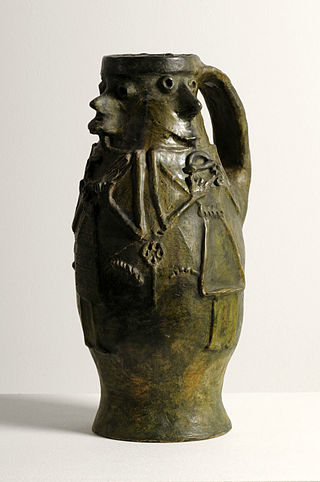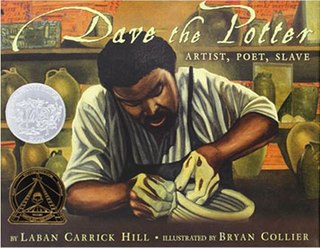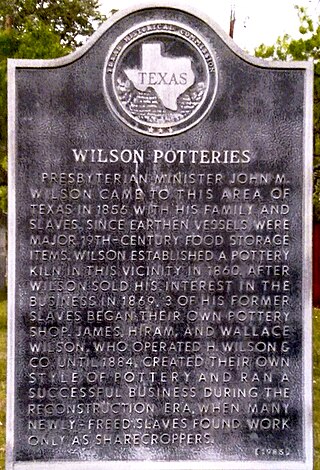Jim McDowell, born 25 September 1945, is a ceramic artist based in Weaverville, North Carolina, who makes face jugs and utilitarian pottery.
Contents

Jim McDowell, born 25 September 1945, is a ceramic artist based in Weaverville, North Carolina, who makes face jugs and utilitarian pottery.

Born in Norfolk, Virginia, McDowell grew up in Washington, DC. His father James T. McDowell, who was called "Ol'Pa" by the family, was in the Navy and was an amateur painter. [1]
McDowell's four-times Great Aunt Evangeline was an enslaved potter in Jamaica who made face jugs. As a young man, Jim McDowell overheard his father and his grandfather, Boyce McDowell, talking about her at a family funeral. They explained that slaves were not given gravestones, so a face jug was sometimes made to serve as a grave marker. [2]
McDowell worked in a coal mine in Pennsylvania before joining the United States Army. Afterwards, he returned to Pennsylvania and resumed work in the mines. Using an entire paycheck, he purchased a pottery wheel and a thousand pounds of clay. [2]
McDowell studied art at Mount Aloysius College and took sculpture classes at Virginia Commonwealth University. As a potter, he is mostly self taught. While he was in the Army stationed at Ansbach, Germany in the 1960s, he had a part time job at the base craft shop that had a kick-wheel pottery wheel. With no one at the base to instruct him, McDowell found a group of German potters in Nuremberg. Although he spoke little German, he explained that he wanted to learn to throw on the wheel. They initially told him no. He persisted and was handed a broom. After sweeping the floor every Saturday for a few weekends, one of the German potters taught him some basic skills on the wheel. [3] He later enrolled in a workshop with potter David Robinson in Weare, New Hampshire. He also studied and worked with ceramicists Jack Troy, Kevin Crowe, David Hovland, David Shaner, and Charles Counts. [2]
"When I first made... [a face jug], I gave it Black features, sometimes exaggerated, thick lips and a broad nose with flaring nostrils. I’ve kept that style. I make teeth out of broken china to give them a scary or fierce look. I sometimes put stained glass on the face so when it's fired the glass runs down like tears." [2]
McDowell's face jugs pay homage to David Drake, an enslaved potter that lived in Edgefield, South Carolina. [4] One of the ways he honors the legacy of Drake is to write on his vessels. He sometimes calls himself "the Black potter." McDowell describes his work as a way to recuperate the labor and efforts of African people and Black Americans. [4] [5]
"I make my face jugs to honor my people who came to this country in bondage through the Middle Passage and not only survived but thrived. I sometimes make a jug to honor a person of color who has achieved greatness or endured tremendous discrimination, or worse. I pay homage to Civil Rights activists and Freedom Fighters whose job, it seems, will never be over. I pay homage to those of my race who taught and wrote and built and preached and orated and invented and created." [2]
McDowell appears in the following videos:

Robert Breckenridge Ware MacNeil was a Canadian-American journalist, writer and television news anchor. He partnered with Jim Lehrer to create the landmark public television news program The Robert MacNeil Report in 1975. He co-anchored the program until 1995. The show eventually became the PBS NewsHour.

A Toby Jug, also sometimes known as a Fillpot, is a pottery jug in the form of a seated person, or the head of a recognizable person. Typically the seated figure is a heavy-set, jovial man holding a mug of beer in one hand and a pipe of tobacco in the other and wearing 18th-century attire: a long coat and a tricorn hat. The tricorn hat forms a pouring spout, often with a removable lid, and a handle is attached at the rear. Jugs depicting just the head and shoulders of a figure are also referred to as Toby jugs, although these should strictly be called "character jugs" or face jugs, the wider historical term.

A Single Shard is a novel by Linda Sue Park, set in 12th-century Korea. It won the 2002 Newbery Medal, awarded for excellence in children's literature. It also received an honorable mention from the Asian/Pacific American Awards for Literature.

Minoan pottery has been used as a tool for dating the mute Minoan civilization. Its restless sequence of quirky maturing artistic styles reveals something of Minoan patrons' pleasure in novelty while they assist archaeologists in assigning relative dates to the strata of their sites. Pots that contained oils and ointments, exported from 18th century BC Crete, have been found at sites through the Aegean islands and mainland Greece, in Cyprus, along coastal Syria and in Egypt, showing the wide trading contacts of the Minoans.

Dame Lucie Rie, was an Austrian-born, independent, British studio potter working in a time when most ceramicists were male. She is known for her extensive technical knowledge, her meticulously detailed experimentation with glazes and with firing and her unusual decorative techniques.

Marguerite Wildenhain, née Marguerite Friedlaender and alternative spelling Friedländer, was an American Bauhaus-trained ceramic artist, educator and author. After immigrating to the United States in 1940, she taught at Pond Farm and wrote three influential books—Pottery: Form and Expression (1959), The Invisible Core: A Potter's Life and Thoughts (1973), and ...that We Look and See: An Admirer Looks at the Indians (1979). Artist Robert Arneson described her as "the grande dame of potters,".

David Drake, also known as "Dave Pottery" and "Dave the Potter," was an American potter and enslaved African American who lived in Edgefield, South Carolina. Drake lived and worked in Edgefield for almost all his life.

Pottery and ceramics have been produced in the Levant since prehistoric times.

Frans Wildenhain also known as Franz Rudolf Wildenhain was a Bauhaus-trained German potter and sculptor, who taught for many years at the School for American Craftsmen at the Rochester Institute of Technology in Rochester, New York.

Gwyn Hanssen Pigott OAM (1935–2013) was an Australian ceramic artist. She was recognized as one of Australia’s most significant contemporary artists. By the time she died she was regarded as "one of the world's greatest contemporary potters". She worked in Australia, England, Europe, the US, New Zealand, Japan and Korea. In a career spanning nearly 60 years, influences from her apprenticeships to English potters were still apparent in her later work. But in the 1980s she turned away from production pottery to making porcelain still-life groups largely influenced by the Italian painter Giorgio Morandi.

Jerry Dolyn Brown was an American folk artist and traditional stoneware pottery maker who lived and worked in Hamilton, Alabama. He was a 1992 recipient of a National Heritage Fellowship from the National Endowment for the Arts and a 2003 recipient of the Alabama Folk Heritage Award. His numerous showings included the 1984 Smithsonian Festival of American Folklife with his uncle, potter Gerald Stewart.

Ceramics in Mexico date back thousands of years before the Pre-Columbian period, when ceramic arts and pottery crafts developed with the first advanced civilizations and cultures of Mesoamerica. With one exception, pre-Hispanic wares were not glazed, but rather burnished and painted with colored fine clay slips. The potter's wheel was unknown as well; pieces were shaped by molding, coiling and other methods,
Klytie Pate was an Australian studio potter who emerged as an innovator in the use of unusual glazes and the extensive incising, piercing and ornamentation of earthenware pottery. She was one of a small group of Melbourne art potters which included Marguerite Mahood and Reg Preston who were pioneers in the 1930s of ceramic art nationwide. Her early work was strongly influenced by her aunt, the artist and printmaker, Christian Waller.

A face jug is a jug pottery that depicts a face. There are examples in the pottery of ancient Greece, and that of Pre-Columbian America. Early European examples date from the 13th century, and the German stoneware Bartmann jug was a popular later medieval and Renaissance form. Later, the British Toby Jug was a popular form, that became mass-produced. Especially in America, a number of modern craft potters make pieces, mostly continuing the 19th-century African-American slave folk art tradition.
Colonoware, which is alternately called Colono-Indian Ware, is a type of earthenware created by African Americans along the Atlantic Coast ranging north and south from Delaware to Florida and as far west as Tennessee and Kentucky beginning in the Colonial Era. It was first identified by the British archaeologist Ivor Noël Hume and shortly thereafter published in a book he wrote.
Quillan Lanier Meaders was an American potter best known for face jugs, for which he was regarded as a master of the form.

Ancient Egyptian pottery includes all objects of fired clay from ancient Egypt. First and foremost, ceramics served as household wares for the storage, preparation, transport, and consumption of food, drink, and raw materials. Such items include beer and wine mugs and water jugs, but also bread moulds, fire pits, lamps, and stands for holding round vessels, which were all commonly used in the Egyptian household. Other types of pottery served ritual purposes. Ceramics are often found as grave goods.

Dave the Potter: Artist, Poet, Slave is a 2010 picture book written by Laban Carrick Hill. Illustrator Bryan Collier won the Coretta Scott King Award and Caldecott Medal in 2011 for his artwork in the book. It was originally published by Little, Brown and Company.
Thomas W. Commeraw, also known erroneously as Thomas H. Commereau, was an early 19th century African-American potter and businessman.

The Wilson Potteries were three related potteries that operated in Capote, Texas, near Seguin, in the latter half of the 19th century, supplying a wide swath of the state with locally-made stoneware vessels for food storage and preparation. One of these, H. Wilson & Co., is thought to be the first African-American-owned business in the state.
{{cite web}}: CS1 maint: numeric names: authors list (link)